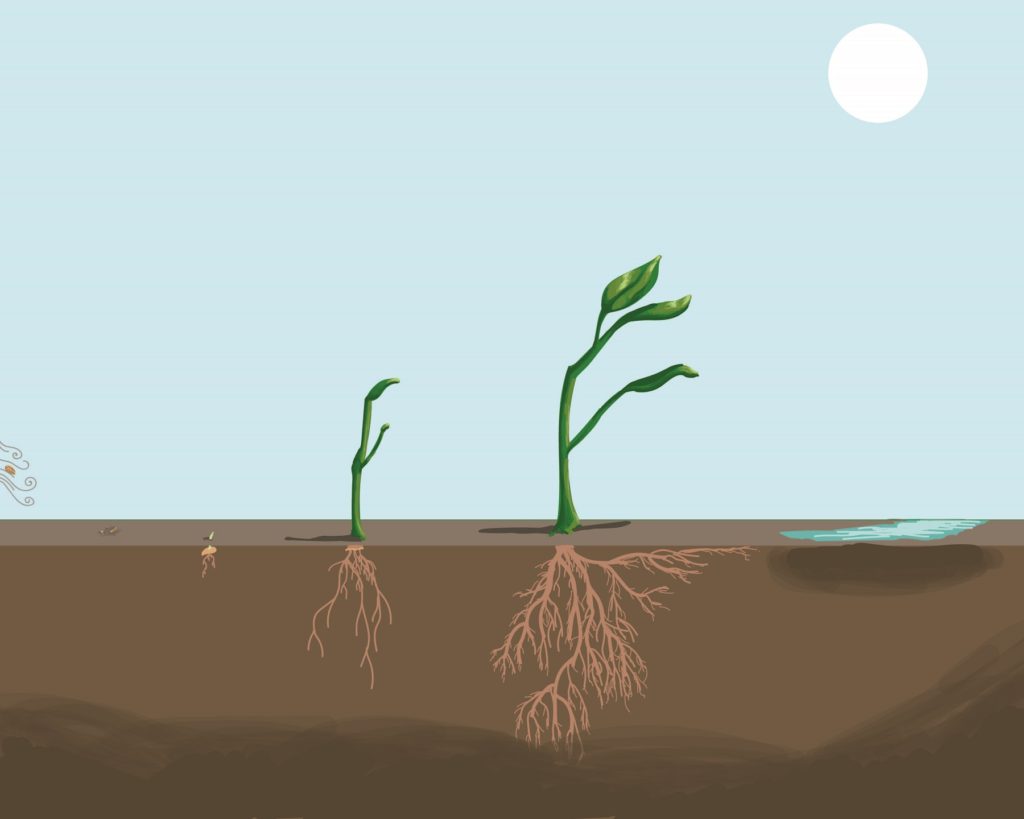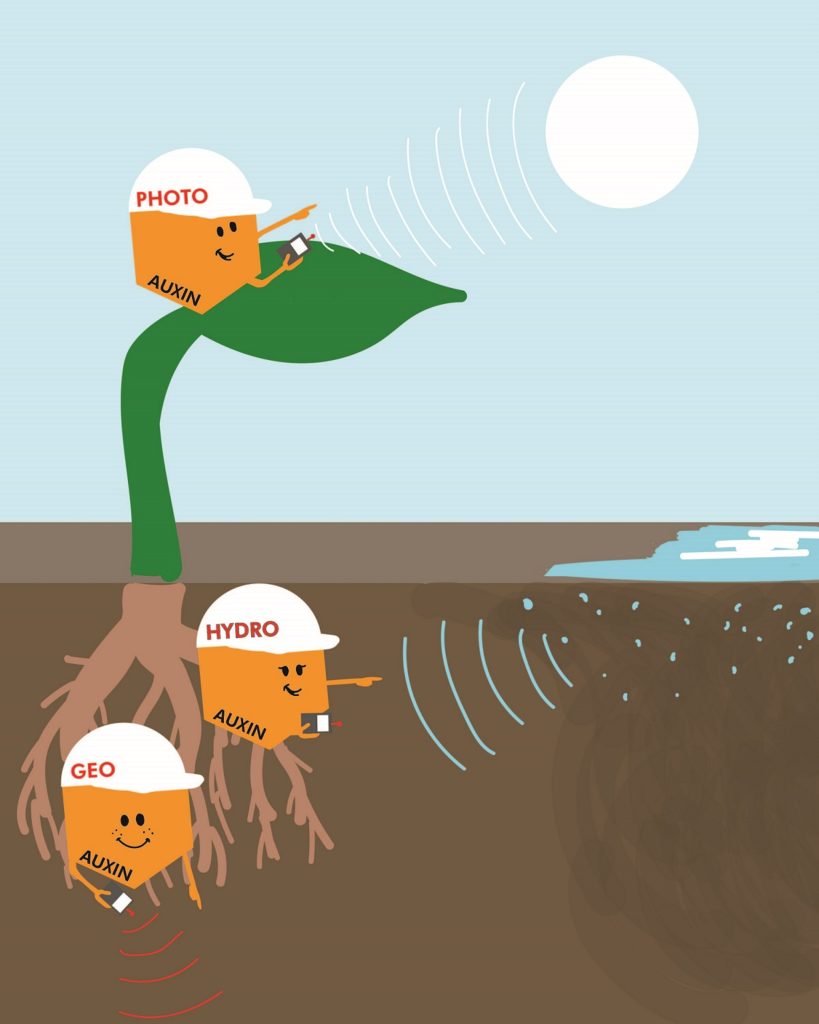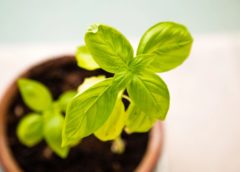How do plants know which way is up and which way is down? No matter which way you put a seed in the soil, it will always send its roots down and its shoots up.
How do plants know which way is up and which way is down? No matter which way you put a seed in the soil, it will always send its roots down and its shoots up. (Unless you’re in space—we’ll get back to that later.)
The answer lies in tropism: motion in response to external stimulus. This is pretty amazing, considering that in the traditional sense, plants can’t move. Specifically, plants are affected by geotropism, phototropism, and hydrotropism. In other words, plants move toward gravity, light, and water, respectively. But these things don’t just happen. A hormone called auxin is responsible.
Plants Know Gravity, Light, and Water


Early on in the history of science, people suspected that gravity played a role in plant development. One of the most famous experiments to test this idea was performed by Thomas Knight, a British physiologist, in 1813. He attached seedlings to a spinning plate, which would allow him to test whether plants would respond to centrifugal force. The seedlings all pointed in various directions, and the wheel was spun at 150 revolutions per minute over many days.
A few days later, after the seeds had begun to germinate, the radicles (beginning shoots) all pointed toward the inside of the wheel, while the roots pointed outward. Of the growth pattern, Knight concluded, “I see little reason to doubt that gravitation is the principal if not the only agent employed, in this case, by nature.”
Shining a Light on Phototropism
Of course, he was wrong. Gravity doesn’t act alone. Light has long been recognized as a major player in plant growth. Charles Darwin observed in his 1880 book, The Power of Movement in Plants, that plants respond to light and move toward the light source. He suggested that an “influence” flows from the part of the plant that is stimulated to the part of the plant that moves. We now know that this influence is auxin, the same hormone that is active in a plant’s geotropic response. More on this below.
It’s easy to test whether light makes plants grow. You simply need to plant a few seeds of the same kind and place one half in a bright spot and the other half in a dim spot. With all other conditions the same, over time, you will find that the plants in the dark experience stunted growth—if they grow at all. And you may notice that the plants in the light bend in the direction of the light source.
Plants in Space
As plants mature, gravity plays less of a role than light does. University of Florida researchers planted seeds of a plant called Arabidopsis thaliana in the weightless conditions of the ISS and found that, although the roots grew in patterns different from those of rooted plants on earth, the plants were mostly able to orient themselves—because they had a light source. According to the authors of the study, it is clear that gravity is neither essential for root orientation, nor is it the only factor influencing the patterns of root growth.
The Jury’s Out on Water
Finally, as any gardener knows well, water is essential to plant growth. Roots sense and respond not only to gravity; they also sense and respond to water. Research has yet to determine what mechanisms plants use to detect water, but it is clear that auxin plays a role in extending roots toward the water source.
Auxin Makes Plants Grow


Phototropism, geotropism, and hydrotropism are possible thanks to auxin, a plant hormone causing growth that is widely distributed throughout the plant and can be found, for instance, in the roots, shoots, and leaves. Auxin causes plants to grow in whatever direction is necessary for their survival. For example, it can force a stem to get taller or to curve in the direction of the light source; it can also affect the shape of a leaf. The auxin in the roots is responsible primarily for geotropism and hydrotropism, while auxin found in other areas of the plant gives rise to phototropism.
Researchers had been aware of auxin since the 1920s and 1930s, and many, most notably Nikolai Cholodny and Frits Went, proposed that auxin could cause growth in plants. Most of the early research was focused on the concept of phototropism. It was not until more recently that auxin was associated with gravity.
Auxin Is a Multitasker
Photoreceptors in the upper parts of a plant sense light, triggering an auxin response. These same photoreceptors play a crucial role in photosynthesis, the process by which plants produce energy. Different stimuli trigger different auxin responses. For example, a nearby plant signals auxin to move the plant away from its neighbor, while ultraviolet light inhibits auxin production, protecting the plant from radiation exposure.
Researchers had long suspected that the gravity-sensing mechanism in plants is located in the root cap, housed in an organelle called statolith (though other theories exist). And in the early 2000s, several publications actually pointed to the presence of auxin in statoliths. In this way, plants can essentially know which way to send their roots and which way to send their shoots.
By relying on tropisms, plants know how to access to food, light, and water, the things they need to survive. Roots can grow hundreds of feet deep; stalks can grow hundreds of feet high; and leaves can grow larger than a person. The next time you’re pondering a hundred-year-old tree or a nascent sapling, remember that these seemingly static plants can move around quite a bit.
References
Blancaflor, E. B. (2013). Regulation of plant gravity sensing and signaling by the actin cytoskeleton. American Journal of Botany, 100(1), 143-152. DOI: 10.3732/ajb.1200283.
Halliday, K. J., Martínez-García, J. F., & Josse, E.-M. (2009). Integration of Light and Auxin Signaling. Cold Spring Harbor Perspectives in Biology, 1(6). DOI: 10.1101/cshperspect.a001586.
Holland, J. J., Roberts, D., & Liscum, E. (2009). Understanding phototropism: from Darwin to today. Journal of Experimental Botany, 60(7), 1969-1978. Available at: https://academic.oup.com/jxb/article/60/7/1969/684486#.
Klein, R. M. (1967). Influence of Ultraviolet Radiation on Auxin-Controlled Plant Growth. American Journal of Botany, 54(7), 904-914. Retrieved from: https://www.jstor.org/stable/2440912?seq=1#page_scan_tab_contents.
Miyazawa, Y., & Takahashi, H. (2007). How do Arabidopsis Roots Differentiate Hydrotropism from Gravitropism? Plant Signaling & Behavior, 2(5), 388-389. Retrieved from: https://www.ncbi.nlm.nih.gov/pmc/articles/PMC2634222/.
Shull, C. A., & Fisher Stanfield, J. (1939). Thomas Andrew Knight in Memoriam. Plant Physiology, 14(1), 1-8. Retrieved from: http://www.plantphysiol.org/content/14/1/1.
Swarup, R., Kramer, E. M., Perry, P., Knox, K., Ottoline Leyser, H. M., Haseloff, J., Beemster, G. T. S., Bhalerao, R., & Bennett, M. J. (2005). Root gravitropism requires lateral root cap and epidermal cells for transport and response to a mobile auxin signal. Nature Cell Biology, 7, 1057-1065. DOI: 10.1038/ncb1316.
Vanneste, S. & Friml, J. (2009). Auxin: A Trigger for Change in Plant Development. Cell, 136(6), 1005-1016. DOI: 10.1016/j.cell.2009.03.001.

